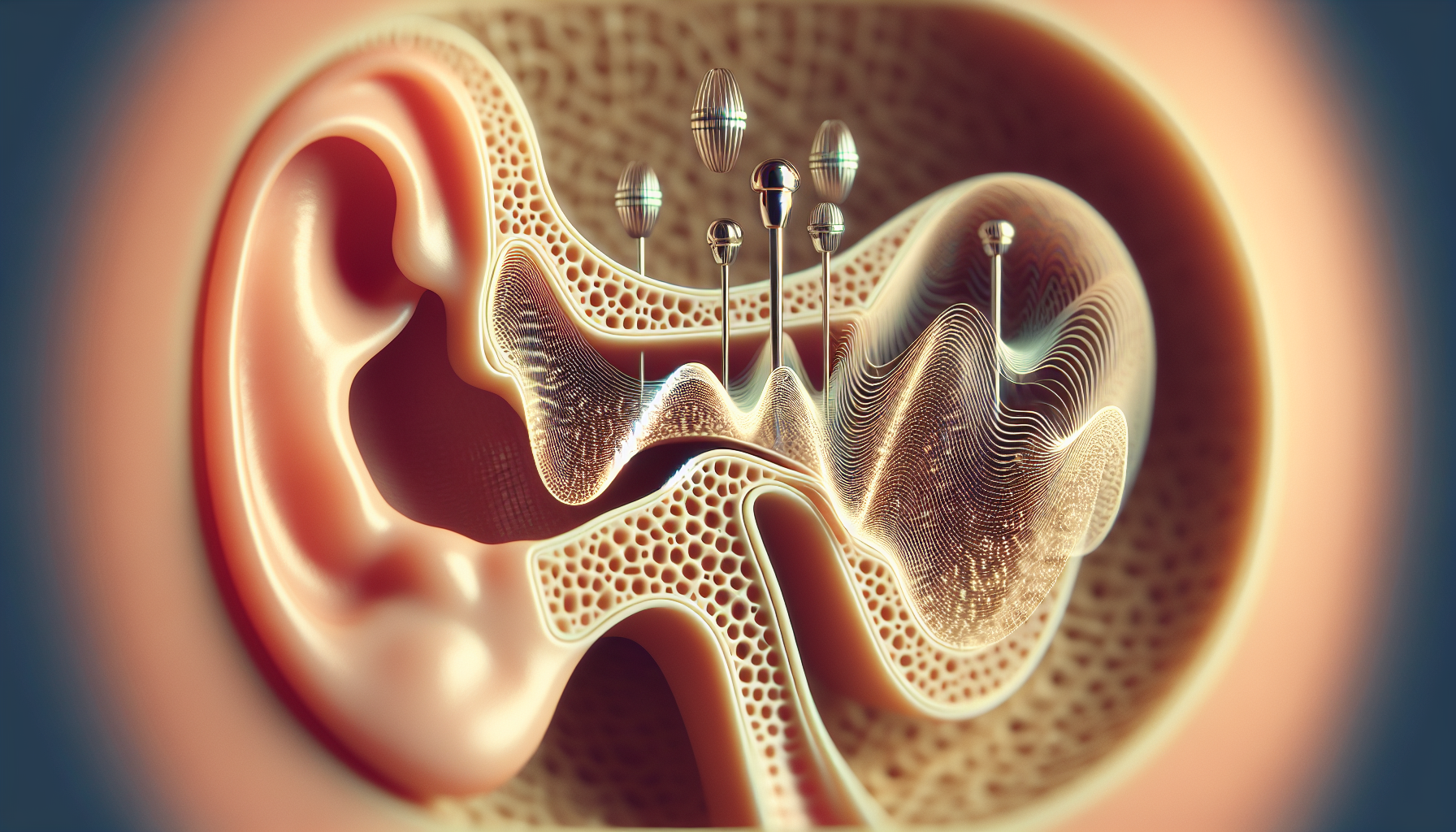
Can AirPods Replace Hearing Aids? Let’s Clear Up the Confusion!
Can AirPods Replace Hearing Aids? With Apple’s latest update, the AirPods Pro 2 can now function as assistive hearing devices. It sounds like a

Fluttering in ear can be perplexing and bothersome. Whether it’s caused by stress, an ear infection, or just wax buildup, understanding this symptom is the first step to resolving it. This article reveals the potential causes of fluttering in ear, helps you recognize when to seek professional help, and navigates treatment options. Get ready for insights into easing that bothersome problem.
Table of Contents
Toggle
Varied metaphors often describe the sensation of ear fluttering. Some liken it to the sound of butterfly wings flapping, while others compare it to hearing helicopter blades or a rapidly beating heart. But the sensation can encompass a broad array of sounds beyond the typical. From clicking, buzzing, throbbing, tapping, crackling, to drum-like thumping, the fluttering sound takes on many forms.
Tinnitus, a condition in which patients perceive sounds like buzzing or ringing in the ears without any external stimulus, is often associated with ear fluttering. This condition manifests differently, with subjective tinnitus being perceived only by the individual, while objective tinnitus can produce noises that can be heard by others, albeit less commonly. Understanding tinnitus symptoms, such as ear fluttering, can help in seeking appropriate treatment.

The intricate phenomenon of ear fluttering is rooted in the complex structures and functions of our auditory system, including the ear canal and the inner ear. The eustachian tube, for instance, plays a critical role in:
When inflammation occurs, it can cause difficulty in opening and closing the eustachian tube, resulting in fluttering sounds in the ear, which may indicate an ear infection.
Middle ear myoclonus (MEM), a condition referring to dysfunctional contractions of the muscles in the middle ear, can also cause fluttering sounds. Not to mention, tonic tensor tympani syndrome, a type of pulsatile tinnitus, can cause spasms in the ear that may be perceived as fluttering.

Understanding what triggers ear fluttering is important beyond just the mechanics. Common triggers include loud noise exposure, stress, and high blood pressure, each offering unique insights into how our lifestyle and health status can affect the auditory perception.
It can be significantly triggered by:
The association between loud noise exposure and ear fluttering underscores the importance of protecting our hearing. Regular use of hearing protection devices when exposed to loud noises, coupled with regular hearing check-ups, can go a long way in preventing both temporary and permanent hearing loss.
It can also be potently triggered by stress. During periods of stress, the incidence of fluttering in the ear can increase, potentially worsening if accompanied by high blood pressure. Under stress, our body undergoes several physiological changes, some of which can trigger or exacerbate it. Some common triggers during stress include:
By managing stress levels and practicing relaxation techniques, you may be able to reduce the occurrence.
The link between stress and ear fluttering reiterates the importance of effective stress management. Techniques such as:
can help manage stress levels, potentially mitigating the occurrence.
Ear fluttering sensations and a greater occurrence of tinnitus are intricately linked with high blood pressure. High blood pressure can compromise blood flow to the cochlea and exert an increased force against the structures of the middle ear, leading to sensations of it.
Furthermore, the sensation due to high blood pressure can be intensified by vascular conditions like capillary malformations and turbulent blood flow, as well as by lifestyle factors such as stress and consumption of alcohol or caffeine. Thus, maintaining healthy blood pressure levels is crucial in managing fluttering.

Fluttering should not be taken lightly, especially if other symptoms accompany it. Immediate medical attention is necessary if it is accompanied by a high fever or discharge coming from the ear. If the it persists, becomes bothersome, or turns chronic, it’s recommended to seek medical evaluation to establish a treatment plan.
Moreover, if ear fluttering is associated with other symptoms, such as:
medical attention is advised.
For those grappling with this in one or both ears, there’s a silver lining — a range of treatment options from medications to nasal douching, and in some cases, even surgery.
These treatments will be further explored in the following subsections.
The treatment arsenal critically includes medication and therapy. For conditions such as eustachian tube dysfunction, various methods such as:
can provide relief.
For underlying conditions such as hypothyroidism that can contribute to it, appropriate medication therapy is essential. Additionally, behavioral therapy can aid in reducing the internal focus on the sounds of ear fluttering, helping individuals cope with any resultant anxiety or depression.
In managing and preventing fluttering, lifestyle adjustments serve as a cornerstone. Here are some strategies to consider:
These activities can contribute to managing stress levels, which may in turn diminish the frequency or intensity of ear fluttering episodes.
Maintaining adequate hydration and a nutritious diet, especially rich in calcium and magnesium, may help prevent ear-related issues, including fluttering sensations. Furthermore, managing earwax buildup through professional methods can prevent potential complications that could lead to this problem.
In cases of ear fluttering related to hearing loss or pulsatile tinnitus, hearing aids and assistive devices can be effective. These devices can help mask the internal noise and provide relief, enhancing the quality of life for individuals dealing with ear fluttering.
The use of hearing aids underscores the importance of regular hearing assessments. Early detection of hearing loss, or hearing impairment, can pave the way for timely intervention, alleviating symptoms and improving overall hearing health.

As with many conditions, prevention is always better than cure, and this certainly holds true for ear fluttering. Avoiding loud noise exposure is crucial as it can lead to tinnitus and subsequent sounds in the ear.
Additionally, maintaining a nutritious diet rich in calcium and magnesium can support overall ear health and potentially prevent ear fluttering. Regular, high-quality sleep contributes to overall health and may help in preventing ear-related issues, including the sensation of fluttering.
The absence of established diagnostic guidelines presents challenges for healthcare providers in diagnosing ear fluttering, often necessitating reference to published case reports. A thorough audiological examination may include hearing tests and imaging studies like MRI or CT scans to search for the cause, taking into account conditions such as Eustachian tube dysfunction and patulous Eustachian tube dysfunction.
Conditions specific to the ear, such as Middle Ear Myoclonus (MEM) or changes during pregnancy, can lead to fluttering sensations, and are considered during diagnosis. Tympanometry, a key diagnostic tool used to evaluate the function and condition of the middle ear and eardrum, is often used to diagnose conditions like MEM that cause fluttering sounds.
Individuals can experience the following symptoms due to this persistent problem:
Moreover, the distracting nature of ear fluttering, combined with the loss of sleep it can cause, may lead to:
Therefore, understanding, diagnosing, and managing ear fluttering is vital to maintaining a high quality of life.
In conclusion, ear fluttering is a complex auditory phenomenon, influenced by various factors such as eustachian tube dysfunction, middle ear myoclonus, loud noise exposure, stress, and high blood pressure. Although diagnosing and managing it can be challenging, a range of treatment and preventive measures, from medication and therapy to lifestyle adjustments and the use of hearing aids, can help individuals lead a comfortable life free from the incessant fluttering sounds.
The feeling could be caused by tinnitus, dysfunction of ear tissues, or high blood pressure. It’s important to consult a healthcare professional to identify the specific cause and find appropriate treatment.
Depending on the cause of the fluttering sounds, various options can be tried to treat it, such as medications, nasal douching, and ear irrigation. Surgical intervention may also be an option in some cases.
It’s important to get your ear checked by a medical professional, as it could be a sign of various conditions such as tinnitus, eustachian tube dysfunction, or other underlying health issues. Fluttering in the ear can be caused by several factors that require proper diagnosis and treatment.
You can stop your ear from pulsing by using sound therapy, such as a white noise machine or wearable sound generator, to suppress the thumping or whooshing sound caused by pulsatile tinnitus. Additionally, the sound of an air conditioner or fan may also help, especially at bedtime.
To prevent ear fluttering, it’s important to avoid loud noise, maintain a healthy diet, equalize middle ear pressure, and ensure regular, high-quality sleep. These measures can help prevent it and protect your ear health.

Can AirPods Replace Hearing Aids? With Apple’s latest update, the AirPods Pro 2 can now function as assistive hearing devices. It sounds like a

Mixed Hearing Loss: A Dual Challenge Hearing loss isn’t always straightforward. Sometimes, it involves more than one issue. Mixed hearing loss is one such complex

Not sure about hearing aids? Let’s face it: missing your favorite TV show’s punchlines or constantly asking people to repeat themselves can be a real

Did you know hearing loss and dementia are linked? This surprising connection is gaining attention in the scientific community. Research suggests a clear link between
Injoy specializes in crafting custom Phonak hearing aid solutions tailored to the unique hearing needs of our patients. With a team recognized as the best in the business and decades of experience in helping people nationwide, we’re dedicated to improving your hearing and, consequently, enhancing your quality of life.
To start your journey towards better hearing with confidence, Injoy is proud to offer a 30-day risk-free hearing aid trial. This allows you to experience the difference our Phonak hearing aids can make, ensuring they meet your expectations and fit your lifestyle perfectly.
Improve your hearing and improve your life today by contacting Injoy to learn more about our risk-free trial!

Explore our range of hearing aids and discover the best option for your lifestyle and Unique Hearing Needs.
Already have hearing aids? We're here to help with any adjustments, repairs, or support you may need.